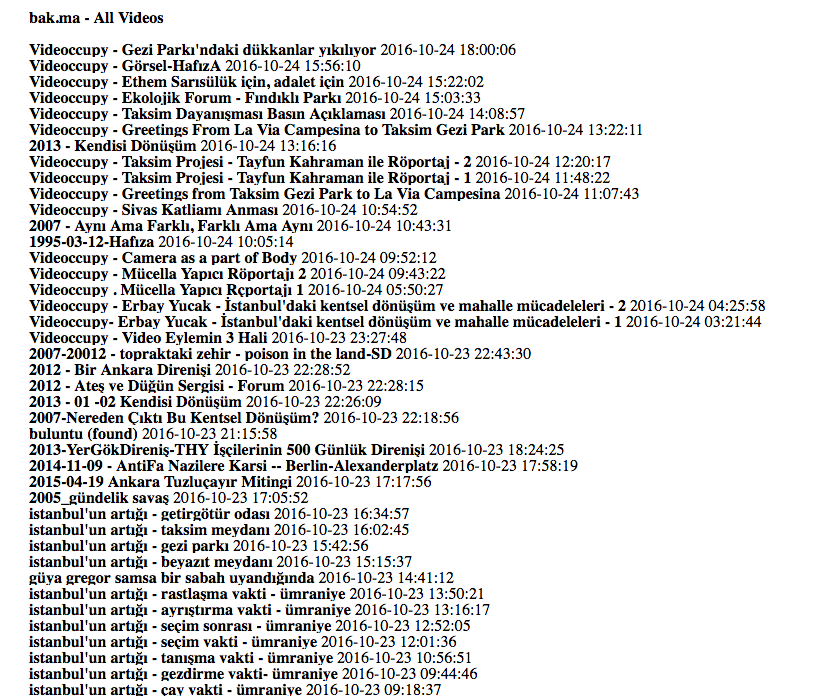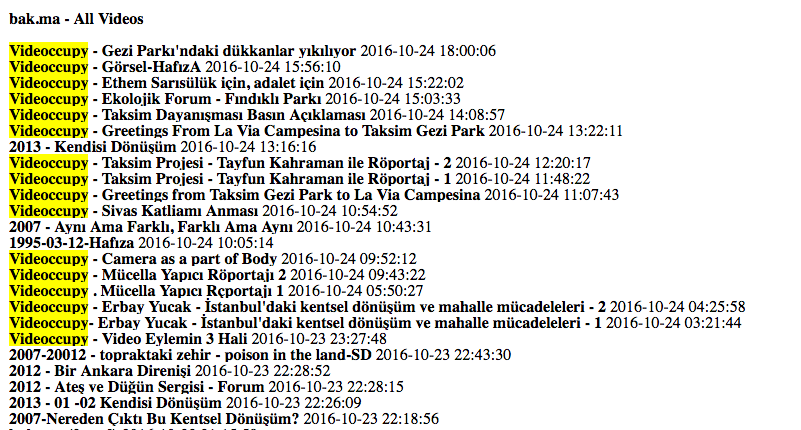Over a year, I have been conducting a research on archiving born digital materials, and my main focus is on occupy movements in Istanbul and New York, and autonomous archives. More precisely, I’m conducting a research on video activism, and their archival practices. By leaving the details of my doctoral study aside, I would like to share my (so far) unsuccessful attempt to visualize a media archival data set, and my case study bak.ma.
bak.ma is a video collective, an anonymous, autonomous, and open access digital media archive of social movements happening in Turkey. “From Gezi to Tekel workers resistance, 19 January to Hewsel, it aims to reveal the near political history of Turkey with audio-visual recordings, documentation and testimonies.” In other words, it is a way of collecting urban witnesses.
In my visualization project, my principal aim is to present the relationship between space and collective memory through visual testimonies of social movements in Turkey. Since I’m a PhD student in urban studies, I aspire to develop a digital project where one can browse all videos recorded in a city/neighborhood/street, and examine urban temporalities. In this framework, the goal is to set up a map with videos that one can play. Furthermore, the desire is to link videos through particular tags. Hence, one can continue to discover more urban temporalities in other parts of the city/in other cities, and might have the opportunity to conduct comparative analysis.
data set & methodology
bak.ma is an open to public archive. You can browse images and texts, and play videos without any registration. Signing up/logging in provides you many editorial features, such as uploading, downloading, and editing images, and adding and editing annotations. Indeed, registered users do not have access to get archival data set. Therefore, as a first step of my meta data project, I requested the archival data set from bak.ma via email. Since I know the collective members, it was easy to get in contact, and receive the data set. It is a list of 20 pages in html format, and composed of 1,022 videos.

At first gaze, it was not possible to distinguish the columns/cells in the data set, but it was pretty clear that it has its own logic. In order to discover it, I went back to archive’s website.

On the website, it is obviously seen that archive can be arranged in five dimensions: Date, categories, tags, keywords, and time of day.
From the html list I chose videoccupy as a keyword, and started to browse archive with the objective of finding its link in the data set: Is it a category, tag, or user name?


On the website, there are 29 videos categorized under videoccupy, but the data set listed videoccupy 18 times; 17 lines starting with videoccupy, and 1 mentioned in the video caption. Meanwhile, I found out on the website that the video is categorized under Gezi. So, through videoccupy keyword, I couldn’t find any direct relationship between the data set in my hand and the archive on the website.

Then I started to view the archive in different forms with the idea of “catching some relations” through different listings: View as list, as grid, with timeline, with clips, as clips, on map, and on calendar.
When I view the archive as a list, I have seen that there are further available data: Title, date, location, tags, language, and duration. Then I went back to my data set, and did a little research for “language”, and the result was null. It does not exist in there.

Then I viewed the archive on map, and I came across with a mapping similar to the one in my mind. Indeed, it was not easy to find small dots, as their sizes are directly related to the number of videos recorded in that neighborhood. Especially, finding a few videos coming from the southeastern of Turkey was impossible. And I could not.
As a result, my data set did not work. But meanwhile I discovered what I need to develop a map like the one in my mind: Date, location, and tags. My first plan is to convert the data list in html into xml / csv. I’d probably have to rewrite all data set, because there are two different data sets including the information that I need.
My next question targets to analyze archival practices: The correlation between the date of record and date of upload. I’m aware that bak.ma collects found footages, and upload them regularly. But, what is the frequency of uploading very recent videos of very recent social movements?
Last but not least, I’d be very happy to hear your comments. Since it is partly linked to my doctoral research, any contribution, in terms of research questions and/or tools, will be appreciated.




